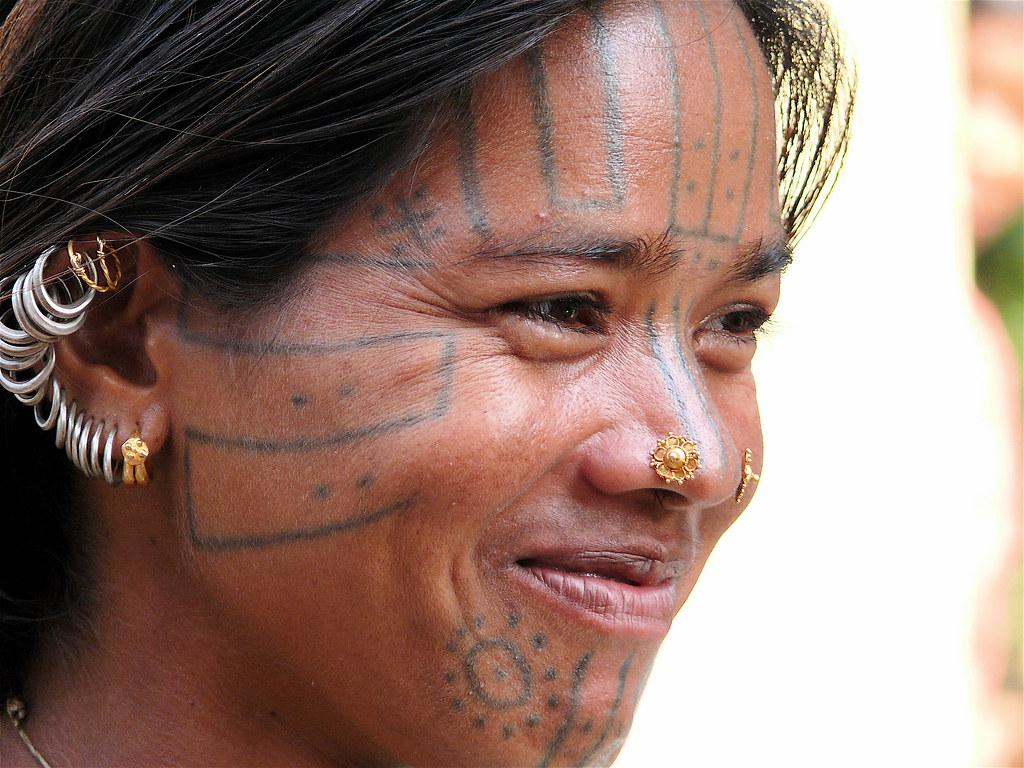
If pain is beauty, the Kutia Kondh women of Odisha have known it for centuries — one thorn-prick at a time.
Buried in the forest-cloaked folds of Kandhamal, these women wore their history not in heirloom lockets or wedding silks, but on their skin — stitched in soot, sealed in blood, and sacred in spirit. Their tattoos weren’t trend, rebellion, or Pinterest boards. They were protection. Proof. Passport.
Welcome to a world where tattoos didn’t just say “this is who I am” — they said, “this is who I must become.”
When Ink Was Destiny, Not Aesthetic
Long before minimalistic wrists and Pinterest-inspired quote tattoos, Kutia Kondh girls underwent body tattooing rituals so intense, they would make the most hardened hippie squirm.

These weren’t done in plush tattoo studios. No gloves. No numbing gel. Just a lemon thorn, a pinch of soot, a touch of gudakhu (tobacco-lime paste), and a steely resolve inherited from generations before.
The process? Brutal. The intent? Beautiful.
A Kutia Kondh girl got her first tattoo, usually on the forehead or face- between the ages of 12 and 14. It was a rite of passage, signalling that she was now a woman, ready to shoulder the weight of community, culture, and, yes — future spirits.
Because here’s the twist: these tattoos weren’t just meant for this life. They were access cards to the afterlife.
Dot. Line. Spiral. Spirit.

Forget barbed wire tattoos or infinity symbols. The motifs inked onto Kutia Kondh bodies were geometric codes of belonging.
Each curve and dot told a story — not just to the living, but also to the ancestors.
Forehead Zigzags: To confuse evil spirits and keep the wearer protected
Cheek Dots: A sign of maturity and marital readiness
Nose Line Tattoos: A signal of vitality and femininity
Chest & Thigh Patterns: Often associated with fertility, loyalty, and prosperity
Neck Arches and Shoulder Fans: Embodying strength and grace
The tattoos weren’t merely decoration, they were cosmic coordinates. Without them, it was believed that a soul might lose its way in the afterlife, unable to reunite with ancestors.
Tattoos, in this culture, weren’t skin-deep. They were soul-maps.
Ink as Armour
In the many tellings of this tale, one thread runs dark and deliberate — the tattoos were once defence mechanisms.
During colonial and princely raids, or tribal abductions, Kutia Kondh women began tattooing their faces more prominently to appear “undesirable” to attackers. What began as camouflage soon became culture.
Because in turning trauma into tradition, these women did what women have always done — they survived. And then, they styled the survival.
Gudakhu: The Grandma’s Ink You Didn’t Ask For

No painkiller. No pre-drawings. Just raw courage and a little tube of gudakhu — a pungent brown paste made of tobacco and slaked lime, usually used for brushing teeth (yes, really).
Once the skin was pricked with thorns, this paste was rubbed into the wound. The resulting infections were intentional — a bigger wound meant deeper pigment, darker tattoo, more permanence.
What’s now seen as unsafe, even shocking, was then considered a necessary pain. The irony? In a world chasing semi-permanent brows and vegan ink, these tattoos have outlived not just trends — but the artists themselves.
The Vanishing Point

And thankfully today, the needle’s gone quiet.
Walk through the villages of Tumudibandh today, and you’ll still find elderly Kutia Kondh women — cheeks dotted, foreheads lined like tribal QR codes. But their daughters? Bare-faced. Bare-bodied. Barely convinced.
The same ink that once marked pride is now mistaken for poverty. With government schools, smartphones, job interviews, and beauty parlours pushing modernity into these remote corners, the next generation isn’t picking up the thorn.
Add to that the internalised shame. Tattooed women have recounted how their facial ink attracted mockery in towns, fear in cities, and rejection on matrimonial sites. So now, what was once a rite of passage is seen as a scar of the past.
A Face Worth Remembering
Every time a Kutia Kondh woman stood in front of a thorn and said, “yes, I’m ready,” she wasn’t just consenting to pain. She was affirming her place in the universe.

In a world where most tattoos say “Look at me,” hers said, “Remember me.”
So the next time you spot someone’s edgy tribal tattoo on Pinterest, pause. Somewhere in Kandhamal, a woman wore it before it was cool — not to flaunt, but to protect herself.
And that, dear reader, is ink that deserves more than double-taps. It deserves respect.
References:
-
Goldby, D. (n.d.). Kutia Kondh tribal tattoos [Photograph].
-
Orissa Post. (n.d.). Kutia Kondh tattoos: An ancient tradition in ink.
-
Flickr. (n.d.). Gudakhu and tribal tattooing tools [Photograph].
-
Insights IAS. (n.d.). Vulnerable tribal groups of Odisha: Kutia Kondh.
-
Frontline. (2023, March 15). Kutia Kondh women face discrimination over tattoos.
-
Odisha State Tribal Museum. (n.d.). Kutia Kondh tribe.
-
Tribal Design Forum. (2022, August 10). Passport to the spirit world: Tattoos of the Kutia Kondh.
-
e-Tribal Tribune. (n.d.). Tribal tattoos as cultural markers.




